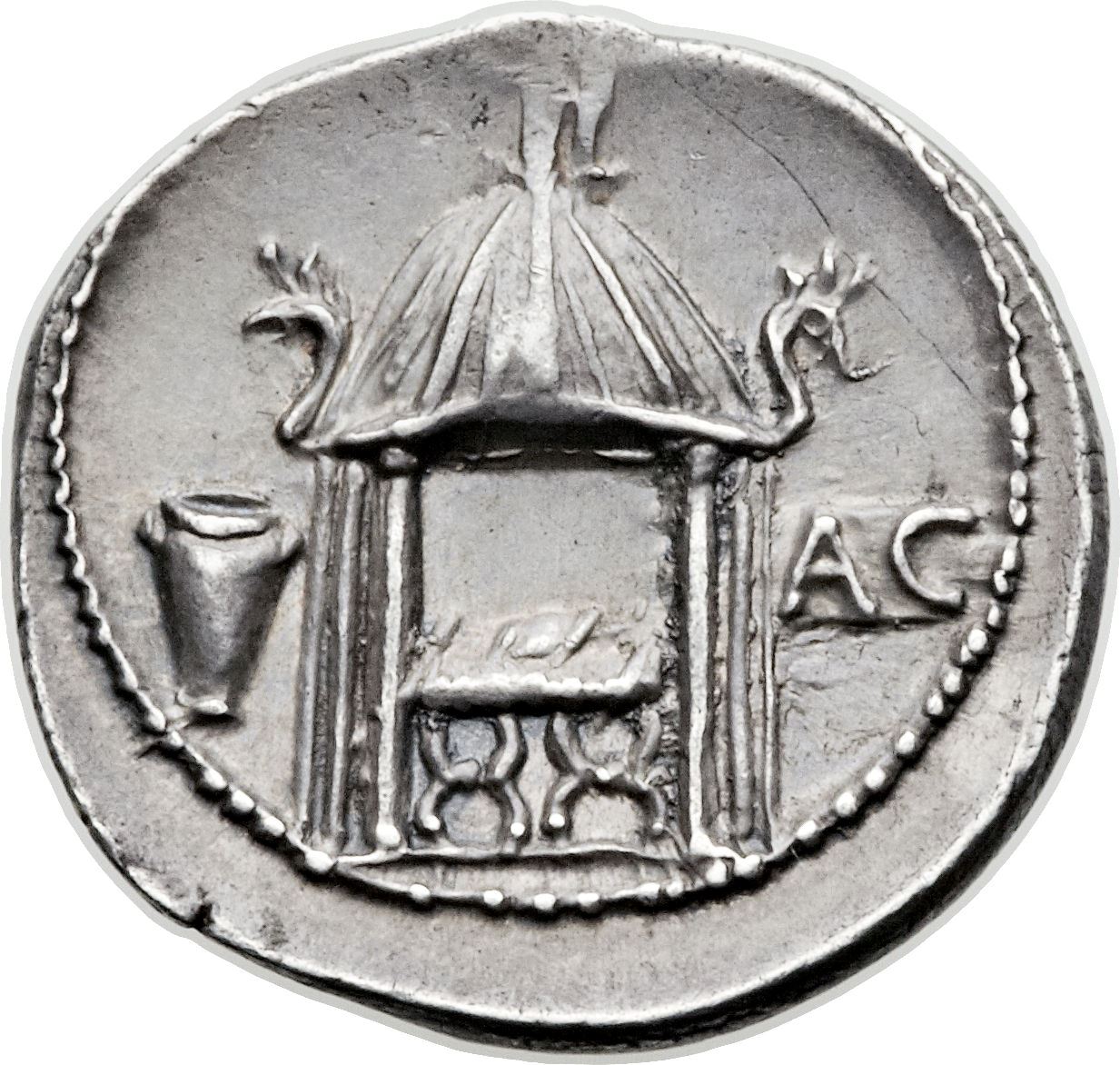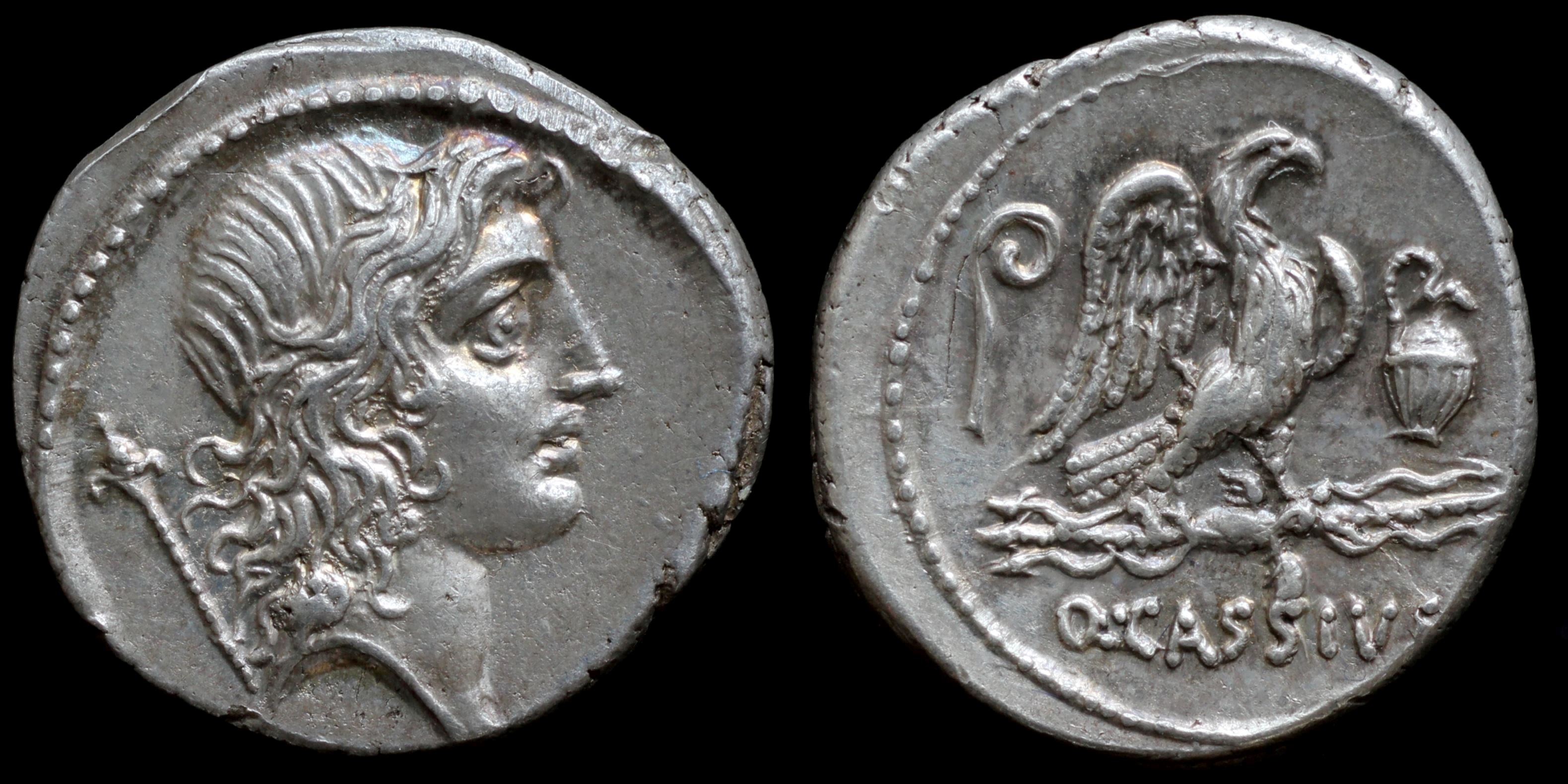Quintus Cassius Longinus was one of the moneyers for the year 55 BC.
He served as a quaestor of Pompey in Hispania Ulterior in 54 BC, and in 49 BC, as tribune of the people, he strongly supported the cause of Caesar. As a reward, he was appointed governor of Hispania Ulterior. He treated the provincials with great cruelty, and his appointment (48 BC) to take the field against Juba I of Numidia gave him an excuse for fresh oppression. The result was an unsuccessful insurrection at Corduba. Cassius punished the leaders with merciless severity, and made the lot of the provincials harder than ever.
At last some of his troops revolted under the quaestor Marcellus, who was proclaimed governor of the province. Cassius was surrounded by Marcellus in Ulia. Bogud, king of Mauretania, and Marcus Lepidus, proconsul of Hispania Citerior, to whom Cassius had applied for assistance, negotiated an arrangement with Marcellus whereby Cassius was to be allowed to go free with the legions that remained loyal to him. Cassius sent his troops into winter quarters, hastened on board ship at Malaca with his ill-gotten gains, but was wrecked in a storm at the mouth of the Iberus (Ebro).
He served as a quaestor of Pompey in Hispania Ulterior in 54 BC, and in 49 BC, as tribune of the people, he strongly supported the cause of Caesar. As a reward, he was appointed governor of Hispania Ulterior. He treated the provincials with great cruelty, and his appointment (48 BC) to take the field against Juba I of Numidia gave him an excuse for fresh oppression. The result was an unsuccessful insurrection at Corduba. Cassius punished the leaders with merciless severity, and made the lot of the provincials harder than ever.
At last some of his troops revolted under the quaestor Marcellus, who was proclaimed governor of the province. Cassius was surrounded by Marcellus in Ulia. Bogud, king of Mauretania, and Marcus Lepidus, proconsul of Hispania Citerior, to whom Cassius had applied for assistance, negotiated an arrangement with Marcellus whereby Cassius was to be allowed to go free with the legions that remained loyal to him. Cassius sent his troops into winter quarters, hastened on board ship at Malaca with his ill-gotten gains, but was wrecked in a storm at the mouth of the Iberus (Ebro).


Obverse: head of young Jupiter (or Bonus Eventus or Genius Populi Romani)* right, scepter behind
Reverse: eagle on thunderbolt right, lituus on left and jug on right, Q·CASSIVS
Diameter:
17 mm
Die Orientation: -
Weight: 4.03 g
Die Orientation: -
Weight: 4.03 g
* The sceptrum, fulmen and aquila point to this being the bust of a young Jupiter, for whom such insignia are normally reserved. The priestly implements on the reverse likely allude to an ancestor who belonged to the college of pontiffs, and if we take the symbolism of this coin to be in reference to Jupiter, then it is probable that this coin is in reference to a family member who was once Flamen Dialis, (high priest of Jupiter), a position of great importance and privilege in Rome that entitled the holder of that office to many honours, including the right to a lictor, the toga praetexta, the sella curulis, and to a seat in the Senate. (ROMA NUMISMATICS historical articles)
Q. Cassius Longinus was brother or cousin of C. Cassius Longinus (Caesar's murderer). He served as a quaestor of Pompey in Hispania Ulterior in 54 BC. In 49 BC, as tribune of the people, he strongly supported the cause of Caesar, by whom he was made governor of Hispania Ulterior. He treated the provincials with great cruelty, and his appointment (48 BC) to take the field against Juba I of Numidia gave him an excuse for fresh oppression. The result was an unsuccessful insurrection at Corduba. Cassius punished the leaders with merciless severity, and made the lot of the provincials harder than ever. At last some of his troops revolted under the quaestor Marcellus, who was proclaimed governor of the province. Cassius was surrounded by Marcellus in Ulia. Bogud, king of Mauretania, and Marcus Lepidus, proconsul of Hispania Citerior, to whom Cassius had applied for assistance, negotiated an arrangement with Marcellus whereby Cassius was to be allowed to go free with the legions that remained loyal to him. Cassius sent his troops into winter quarters, hastened on board ship at Malaca with his ill-gotten gains, but was wrecked in a storm at the mouth of the Iberus (Ebro). His tyrannical government of Hispania greatly injured the cause of Caesar. (wikipedia)
Crawford 428/3, SRCV I 391, Sydenham 916, BMCRR 3868, RSC I Cassia 7
